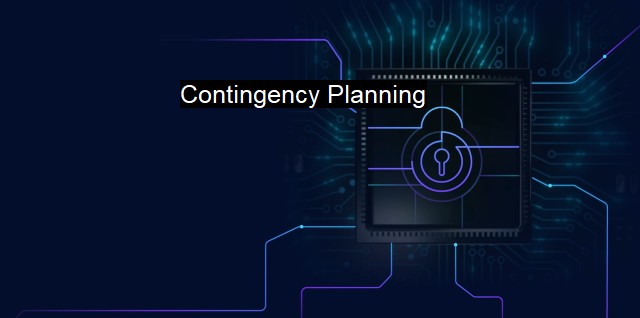What is Contingency Planning?
The Significance of Contingency Planning in Cybersecurity and Antivirus Protection in the Digital Age: Definition, Importance, and Applications
Contingency planning is a crucial aspect of strategic preparation in various fields, including cybersecurity and antivirus protection. It refers to the process wherein an organization or an individual develops and implements effective strategies and actions to cope with possible future events that may disrupt ongoing operations. More specifically it involves strategies to prevent, react to, and recover from incidents that compromise the security and integrity of IT systems and data.Cyber threats are ever-evolving and increasingly sophisticated, posing serious risks to sensitive data, intellectual property, network infrastructures, and digital technologies globally. Despite substantial investments in cybersecurity tools and practices, no system is completely invulnerable. Thus, contingency planning becomes an integral part of cybersecurity and antivirus protection, as it provides a guiding course of action in the event of cyber-attacks, system failures, or even human errors.
Effective contingency planning begins with risk assessment and impact analysis, identifying potential vulnerabilities and the likely outcome of potential threats. From an operations perspective, it's essentail to identify services, functions, or activities worthy of protection. this includes information and systems that, if compromised, could disrupt services, violate laws and regulations, or cause financial loss.
One way to achieve effective contingency planning could be through creating an incident response plan. This could outline steps to be undertaken once a potential security breach has occurred, including technical and operational procedures to minimize the damage and attack duration. It's also vital that these plans entail restoring systems and data, thus minimizing chaos, and ensuring business continuity.
Contingency planning also deals with creating a disaster recovery plan. This plan includes strategies and procedures to restore hardware, applications, and data in a timely manner to enable continued operations after a catastrophe such as a natural disaster, power failure, or cyberattack. Given the critical role of technology in contemporary business operations, having a disaster recovery plan in place is absolutely crucial.
Another key component of contingency planning is the establishment of a business continuity plan. Unlike disaster recovery, which focuses primarily on recovering IT infrastructure and digital technologies in the aftermath of a crisis, this plan aims to ensure an organization continues running its critical business processes during and after a disaster.
It should be noted that contingency planning is not solely a technological issue. Cyberattacks or IT outages can have profound human, organizational, and financial implications. This tactic includes educating employees about cybersecurity, comprehending the cross-functions of different departments in response to a cyber threat, and factoring in the potential financial impact of such incidents. therefore, its strategies should integrate a holistic consideration of all aspects of business operation.
Periodic testing and practice of contingency plans help identify potential issues and ensure readiness. Simulating situations such as a distributed denial of service attack or natural disaster is beneficial in removing any operational kinks and preparing the team in the face of any eventuality.
Today's digital networks and spaces are fierce, dynamic battlefields posing countless threats to information security, necessitating comprehensive contingency planning. With proper strategies in place, organizations can ensure a greater level of resilience against cyber threats and other disruptive incidents, minimizing the impact on business continuity and financial stability. Hence, while prevention is always better than cure, in an unpredictable cyber atmosphere, having robust contingency plans can help brace against the unforeseeable and the inevitable. As the renowned saying goes, "Failing to plan is planning to fail."

Contingency Planning FAQs
What is contingency planning in cybersecurity?
Contingency planning in cybersecurity refers to the process of identifying potential risks and developing a plan of action to address those risks in the event of a security breach or other cyber incident. The goal is to minimize the impact of the incident and ensure that critical systems and data are protected.What are the key components of a contingency plan in cybersecurity?
The key components of a contingency plan in cybersecurity include identifying potential risks and vulnerabilities, establishing procedures for responding to security incidents, ensuring regular backups of critical data and systems, and establishing communication protocols and roles and responsibilities for key personnel in the event of an incident. It is also important to regularly test and update the plan to ensure its effectiveness.Why is contingency planning important for antivirus protection?
Contingency planning is important for antivirus protection because even with the best antivirus software and other security measures in place, there is always a risk that a cyber attack or other incident could occur. A contingency plan ensures that there is a plan of action in place to respond to these incidents and quickly mitigate any damage.How can businesses ensure that their contingency plan is effective?
To ensure that a contingency plan is effective, businesses should regularly review and update the plan to reflect any changes in their systems, operations, or risk environment. It is also important to conduct regular training and testing exercises to ensure that key personnel are familiar with their roles and responsibilities in the event of an incident. Finally, businesses should work with cybersecurity experts to identify potential vulnerabilities and ensure that their contingency plan addresses these risks.| | A | | | B | | | C | | | D | | | E | | | F | | | G | | | H | | | I | | | J | | | K | | | L | | | M | |
| | N | | | O | | | P | | | Q | | | R | | | S | | | T | | | U | | | V | | | W | | | X | | | Y | | | Z | |
| | 1 | | | 2 | | | 3 | | | 4 | | | 7 | | | 8 | | |||||||